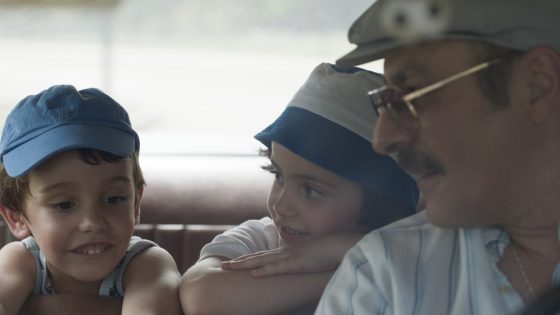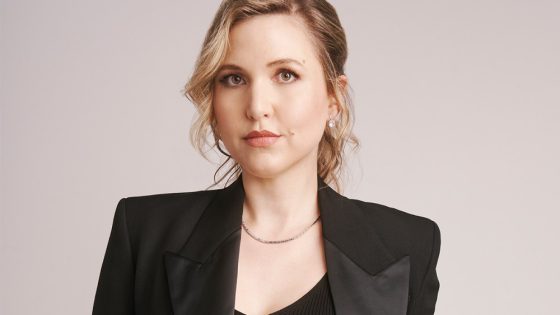Write about what you know, the old adage runs. In “Rita,” her debut as a writer-director-producer, Spain’s Paz Vega has certainly taken that to heart. Years before breaking out with 2001’s “Sex and Lucia,” then starring opposite Adam Sandler in 2004’s “Spanglish,” Vega grew up in Triana, a district of Seville, in Spain’s Andalusia.
Set in 1984 in an unpretentious part of Vega’s native city, “Rita” co-stars Paz, one of Spain’s best-known faces in international cinema, but it’s a literally self-effacing turn. Although she plays Rita’s mother Mari, and she’s present in multiple scenes, her face is not seen until minute 14 of the film. The focus is on Rita, 7, just one year younger than Vega in real-life in 1984, and her little brother, Lolo, 5.
This is for the most part, or the earlier part of the “Rita,” a nostalgic recreation of Paz’s childhood whose redolence is one reason Vega’s debut is world premiering at Locarno on its Piazza Grande where Locarno Fest screenings are reserved for broader audience films.
“Rita” records the bric-a-brac of an ‘80s childhood. An initial two-minute pan creeps from a rudimentary metal fan, over notebooks, cartons of crayons, a period toy lorry, an action man on the carpet, a small basket of marbles, a manual arm clock, to Rita, just waking up on her top bed bunk. The pan lasts in all over two minutes.
“Rita’s” retro repertoire takes in, however, not just objects but sounds and sensations: That same pan catches Rita clambering down the ladder from her bunk her bare feet on the metal rails: Anybody who has done so will remember the singular but passing discomfit, or the robust ring of an ‘80s fixed line telephone, or the dry scald of handling hot toast straight from a toaster.
Soon, however, in “Rita,” the young girl is hearing other sounds: the muffled shouts of her father José Manuel, tearing into her mother Mari, and what could be the dull thud of punches.
The first part of “Rita” records childhood bliss, the second part, ever more, its blight.
Focusing on the impact of domestic violence on children as seen by children, it is also the work of an auteur.
“This is the powerful work of a writer-director. As Locarno director Giona A. Nazzaro commented to Variety, while Paz Vega is a superstar, in ‘Rita,’ she emerges as a true filmmaker, becoming invisible in the service of the story,” says Irene Airoldi, at Filmax, the film’s sales agent and domestic producer.
“Rita” is produced by Marta Velasco and Gonzalo Bendala at Aralán Films, one of Andalusia’s leading production houses, behind Carlos Vermut’s “Quien te cantará” and Patricia Ferreira’s “The Wild Ones,” in association with Ola Films and Madrid-based post-production facility Arte Sonora Estudios.
Paz Vega
Credit: Bea Hohenleiter
Variety talked to Vega in the build-up to Locarno:
You play Rita’s mother Mari, but from the film’s very title to the first shot, the focus is on Rita….
That was my very first idea when this movie came to mind. There are so many movies about this subject [of domestic violence]. But it’s newer to see the subject through the eyes of a child: How they know about everything around them and try to understand the universe of the adults. We tend to underestimate children. They’re very intelligent.
One brief example is when mother Mari, Rita and Lolo are on a bus, and Rita offers Mari her place, standing by the window…
Yes, a man’s standing too close to Mari. Rita realises. It’s very interesting to explore how children live complicated family situations, as well as how they use their imagination to escape reality, for example. Rita is always drawing, drawing reality how she’d like it to be.
Rita also likes to go outside, feeding the birds in the park, or lying on the grass and looking at the clouds. That’s no coincidence….
My idea was that the flat was oppressive, and not just because of the heat, but because of the negative energy there. So when Rita goes up to the apartment block roof terrace, she feels happy, free. Going out is a moment of happiness and hope.
There’s also a constant sensorial sense to childhood, even in the most mundane of actions such a climbing down a bunk ladder…
I had a bunk like that! And folded the tablecloth like Rita does when she clears up after dinner. People can connect with these things and when they do, they make the film their own and enter Rita’s life in a way.
As a director, you would appear to like in-frame framing…
For me, framing is primordial in cinema. It was fundamental that what is in the frame has a meaning, but it’s as important what’s off camera, where the adults don’t appear, but we hear what’s happening. It creates a sensation of anguish not seeing what’s happening and seeing the children’s reaction who don’t need to watch their parents quarrelling. My focus is on how parents’ toxic relations impacts the children.
That takes in Lolo, who’s a delicate child. For his father José Manuel he’s a failure , he’s not machito enough; the audience will expect he might have hit him.
Yes, it’s very interesting. The relationship of the father José Manuel with Lolo is one of badly understood masculinity. It’s a toxic masculinity. The father wants the boy to be a macho because surely his own father forced him to be one. For José Manuel, Lolo just isn’t up to scratch. It’s a chain reaction who passes from one generation to another and people who have a father like that suffer a lot.
One question which a lot of people might ask you is: After having worked with so many acclaimed directors, have any influenced you significantly when you set out to make your first film as a director?
I’ve tried not to be similar to anybody because it’s a very personal story. I already had images in my head from the very beginning. I love how some directors work with actors, such as Sean Baker. I loved Jonathan Glazer’s “Zone of Interest.” But the film has nothing to do with “Rita.” Maybe there are shots of daily life in the streets which remind me of Italian neorealism but “Rita” has its own essence, and that’s for the good.
You’ve worked in many countries, but chose to make your first film as a director in Spain in your native Andalusia.
I’m from Seville, lived my childhood in the ‘80s, it’s the childhood I know. That gave me the power of truth. Apart from the domestic violence, everything else that happens to Rita I’ve experienced. Rita’s neighbourhood, her mum’s work as a seamstress, that’s my story too. It’s me.
And the cast and crew are all Andalusian?
Everyone, except for Roberto Álamo, who plays José Manuel who is from Madrid. It was good to have him coming from outside Seville, so that he feels isolated, in a place which isn’t his own, which means he’s perpetually angry, in a hot city, bringing up his family, working all day long. There were many fathers who felt they were doing the right thing but were wrong. For me, José Manuel is another victim of a model of masculinity.
Source Agencies




